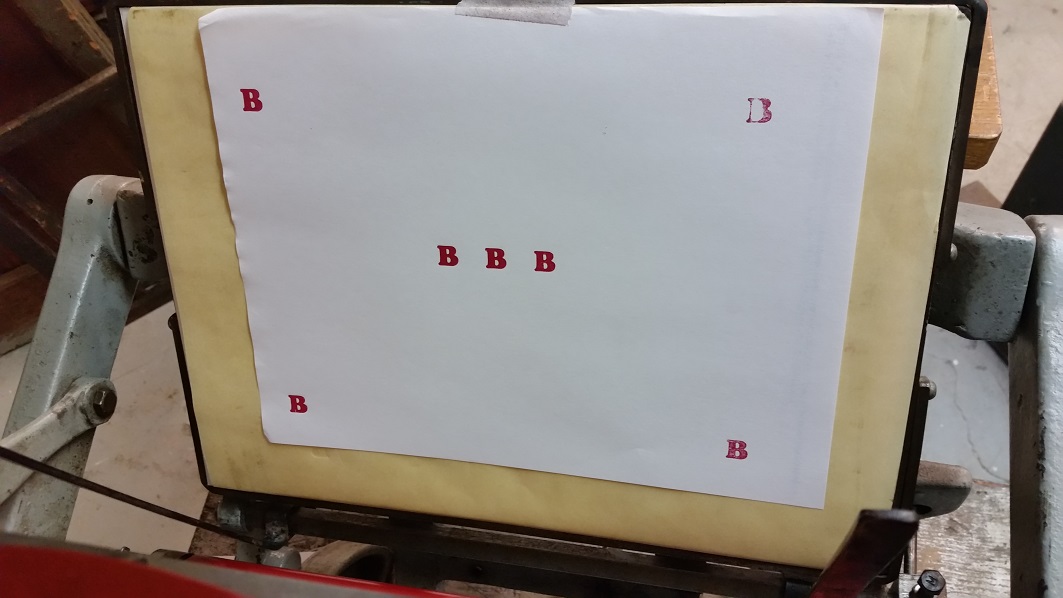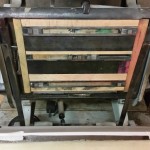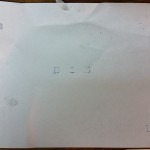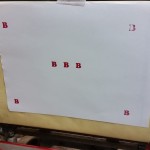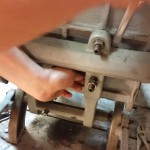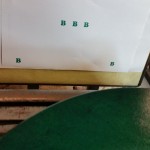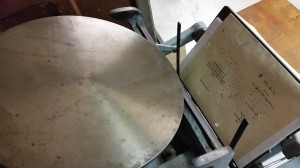
After a long sojourn, my Craftsmen Monarch press has finally come home. Years ago, when I first acquired the print shop from Otto Graser (a founding father of the Ottawa Press Gang), I was so excited at the prospect of using the Reprex cylinder press, I could see no reason why I would want to use a platen press. The prospect of setting type, locking it up and then standing it on a vertical axis to print just seemed like a recipe for disaster – at least, to this neophyte.
And so, the platen press found a home with a fellow gangster for several years. I didn’t really miss it. Until I started working at the local history museum, where I met the beautiful and imposing Chandler and Price New Series (14 x 22), used for public interpretation and demonstrations. I learned not to fear the vertical form (assuming I locked up properly!); I learned first hand how this workhorse is steady and reliable and prints with grace and beauty. And its design, like so many early machines of the printing trade, is thoroughly ingenious and steampunk.
When I heard that the Monarch press was sitting idle in my fellow gangster’s basement (replaced, in favour of the majestic Vandercook), I decided that it was time to get it home and put it to work. The gangster cautioned me; he’d always had trouble getting good impressions: he recommended that it get a thorough tune-up and restoration. “No problem!” I countered. After all, hadn’t I read every trouble-shooting article on Briar Press and Letterpress Commons? I had a good set of wrenches. I could do it — Easy-peasy, right?!
Not only was this little cast iron 300-pound press slightly off its rocker, so, apparently am I. I managed to fix most of the easy stuff: a little steel wool and machine oil to remove the rust on the platen and press bed; cleaning and oiling away the grime; carefully testing and tightened the loose nuts; leveling and re-fastening the feed board. But I’m not sure what possessed me to think I knew how to level the platen.
If you are seeking guidance on how to correctly level the platen, this is probably not the blog for you. I did, however, document the process – and perhaps this can serve as something of a cautionary tale to any other newbie who naively thinks he can take a few quick turns on the impression screws before printing his magnus opus.
I needed to determine what kind of impression problems I was facing. I started by setting up a forme of uppercase B’s located in the centre and four corners of the forme. (I used 36-point Cooper Black as the test type, as I had nothing larger.) I used standard packing: tympan drawsheet over pressboard, index sheets and bond. Then I drew some proofs to see what my baseline was. The first impression (picture 2) was hardly making contact with the type – and the inking was inconsistent across the forme. I modified the packing slightly, but saw little improvement. So, I took the next logical step and started tinkering with the platen itself; slowly adjusting the upper and lower impression screws and taking proofs with each adjustment. It took me most of the day to improve the impression (see picture 3); but still one corner was not inking fully.
So close! I was both excited and exasperated. I tinkered a little more furiously. I’d exhausted my repertoire of swear words in English, and resorted to the immensely-satisfying blasphemy of my French Canadian roots. I turned the screws with more abandon. I pinched my fingers… a lot.
In retrospect, I should have called it a day. If this exercise has taught me nothing else, it is to know when you have lost focus and the sheer enjoyment of getting acquainted with your press. By the end of the day, I was back where I’d begun: poor impressions; a wildly uneven platen.
Day 2. Having recovered my composure (a little white wine and a good night’s sleep) and consulted once more a variety of letterpress resources (see list below), I returned to my task with resolve. Back to the very start; I loosened all the screws so that there was no tension on the platen at all (picture 4). Starting with the bottom screws (Thank you, thank you, Fred Williams!), I tightened each one, a quarter-turn at a time – and kept scrupulous measurements with each step. Once the bottom screws were adjusted so that the proofs were inking nicely at the bottom of the forme, I approached the top screws.
These proved to be little trickier: I discovered during this process that the grippers were improperly attached to the platen with an ill-fitting replacement spring. Each time I tightened the top screws, the rollers would be pinched by the grippers on the up-stroke. The impression was improving but the rollers were getting stuck! Definitely time for coffee and a break to think about how to tackle this.
Not only was the platen unlevel, but the gripper assembly was a makeshift arrangement that interfered with the press stroke. In the end, I removed the entire gripper assembly so that I could resolve the leveling problem. Once the grippers were out of the way, I was able to adjust the upper impression screws so that I had consistent inking all across the forme (see picture 5). Finally! A good impression at last!
The next challenge will be to track down a suitable replacement for the gripper assembly. It seems that the gripper spring and spring holder were replaced with parts from a different press. The whole assembly is loose and gets in the way when the platen closes. I’ll save that for another day.
In closing, let me echo the words of “Inky” (briarpress), who knows whereof he speaks!
You are wise to avoid messing with the platen adjustment screws. There are two kinds of people who mess with the platen. Those who know what they are doing, and those who are looking for grief.
Leveling your platen? Here’s a list of useful resources:
Leveling the Platen Press, by Fred Williams (Editor & publisher). Type & Press, Winter 1985.
Press Packing (Troubleshooting, Briarpress.org)
Leveling the platen on a 8 X 12 C&P old style. (Troubleshooting, Briarpress.org)
Platen Press Operation. George Jackson Mills. Carnegie Institute of Technology, 1959.
Elementary Platen Presswork. Ralph Weiss Polk. C. A. Bennett Company, 1955
